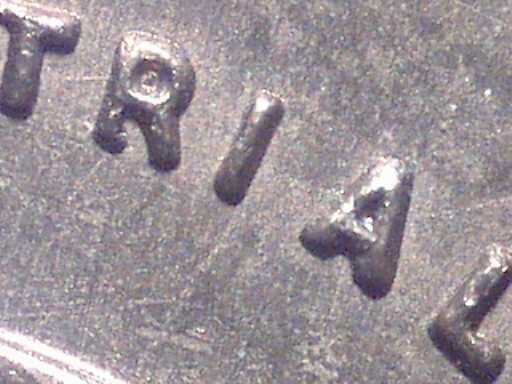
Imaged above are the raised letters seen through
a QX3+ microscope at 2400 dpi resolution.
All images below have been displayed at
260 dpi to print out 2.6 times the actual size.
The Actual TRIAL coins will be on display only over Weekend.
A TRIAL or Pattern maybe struck when a new coin metal or design is to be selected. Since only a few pattern coins are minted, and most are melted at mint the pattern types which are not selected for legal tender become very rare collectors items found mostly in mint museum collections.
Exhibited are eleven patterns from Sri Lanka most still unlisted in the Krause & Mishler Standard Catalog of World Coins.

Imaged above are the raised letters seen through
a QX3+ microscope at 2400 dpi resolution.
All images below have been displayed at
260 dpi to print out 2.6 times the actual size.
The Actual TRIAL coins will be on display only over Weekend.
In 1942 in a selection process for the new type of coin to conserve metal for the war, a pattern was struck in Black Bakelite plastic in high relief. It was manufactured by a Private Firm and sent to Ceylon for evaluation. This pattern was not durable for circulation, and on 1942 September 8th, a bronze coin of half the original weight was selected for circulation.
|
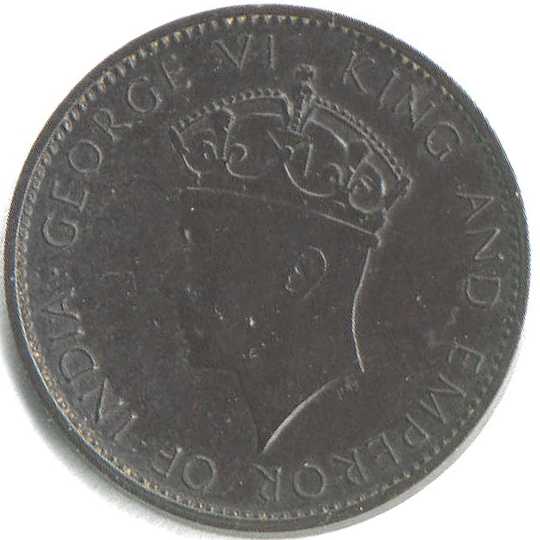
|
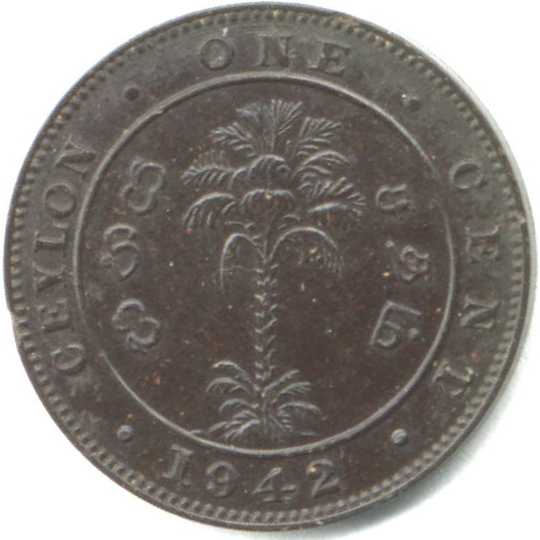
| ||||||||||||
| KM Unlisted | ||||||||||||||
Obverse : Crowned effigy of George VI to left in high relief
in the center of the legend GEORGE VI KING AND EMPEROR OF INDIA,
along periphery.
Initials of designer P M in relief below the
truncation.
Reverse : A Talipot palm in the center,
Left Sinhala satheyer; Right Tamil Satam.
CEYLON . ONE . CENTS and year 1942 below along periphery.
The Pattern was sold at Dick Ford collection Taisei-Baldwin-Gillio Auction #19 23 Feb 1995 lot 255 for US$400+10%, claiming to be the only specimen of the few known in private hands. This is another.
This Lankan Bakelite Pattern is interestingly similar to the 1942 WWII - US patterns including one in Bakelite.
|
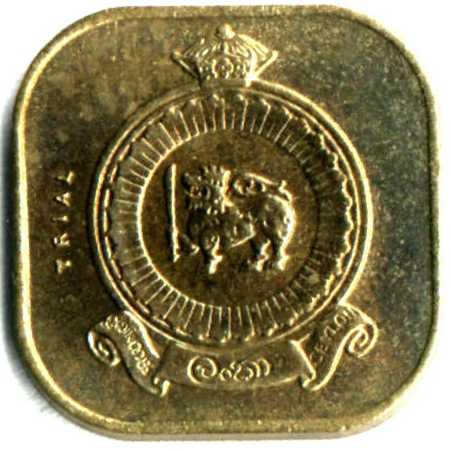
|
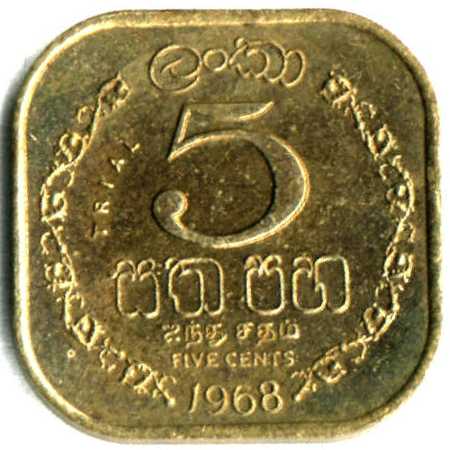
| ||||||||||||
| KM unlisted | ||||||||||||||
|
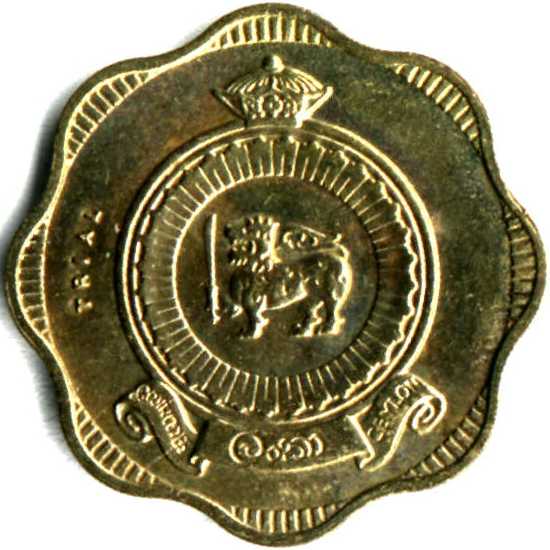
|
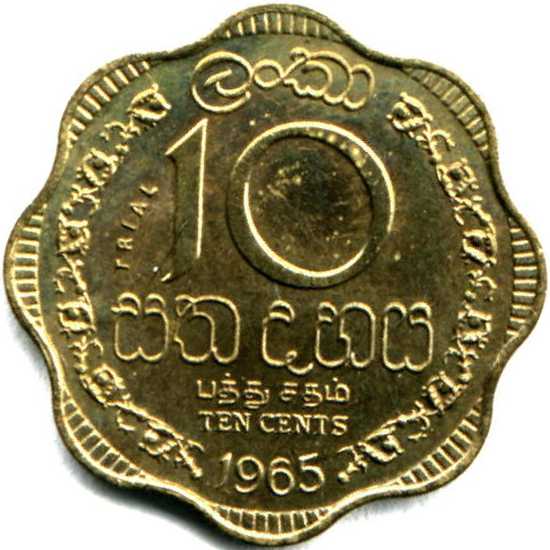
| ||||||||||||
| KM unlisted | ||||||||||||||
Obverse : The Armorial Ensign of Ceylon, with raised word TRIAL to the
left (9 O'Clock) along the periphery.
Reverse : The large numeral with the value in Sinhala, Tamil and
English below and year of issue at the bottom within a circle of the
traditional Sinhala Liyavela art with Lanka in Sinhala on top.
Raised word TRIAL to the left and upper side (10 O'clock)
just inside the Liyavela.
The curator of the British Royal Mint Museum has confirmed that their coin cabinet did have a few specimens of the 1968 5 cents TRIAL with a ticket which says they were sent to them in the early 1970's from the Birmingham Mint. The 10 cents TRIAL maybe Unique !!
|
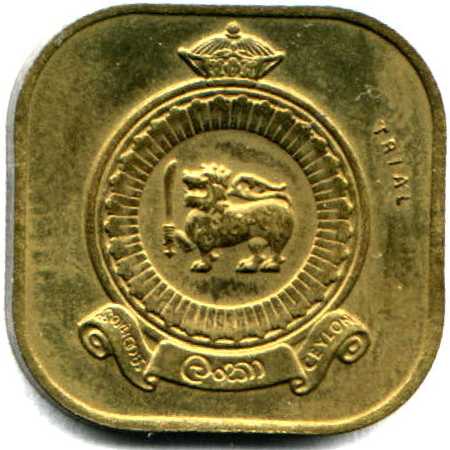
|
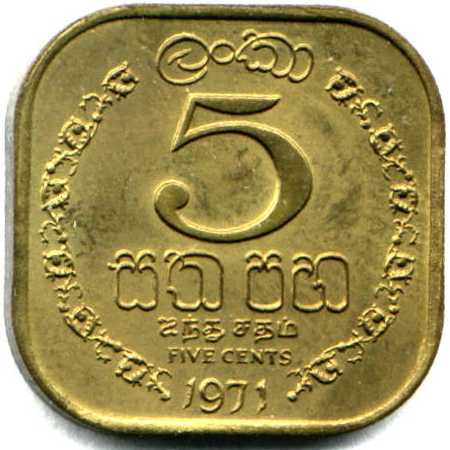
| ||||||||||||
| KM unlisted | ||||||||||||||
|
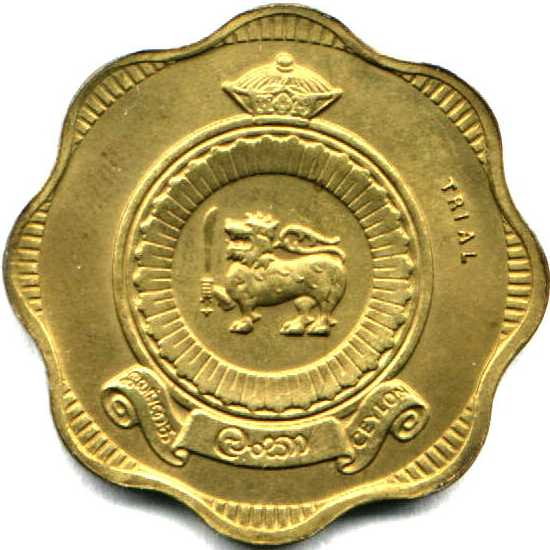
|
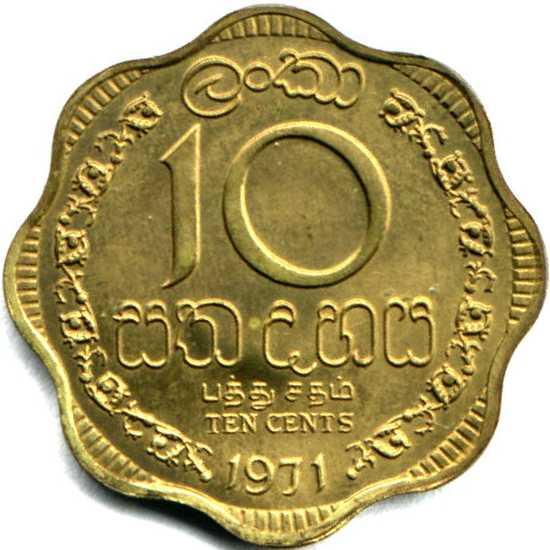
| ||||||||||||
| KM unlisted | ||||||||||||||
In clad coins the main cause of concern was rust setting in the rim of the coin. Corrosion sets in the tropics much faster than in the colder climate countries. 2.5-sets known in private hands.
A set of TRIAL patterns were struck in 1971 in Chromized Steel to select a cheaper alloy for the Five cents and Ten cents coins.
|
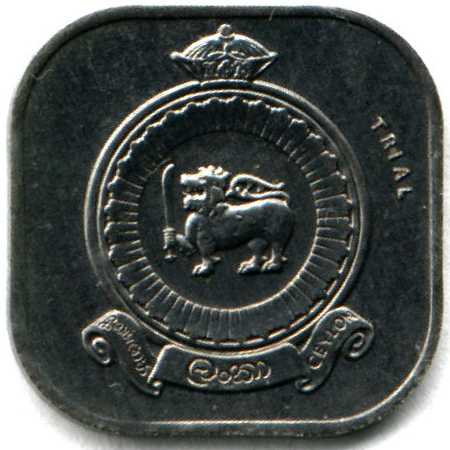
|
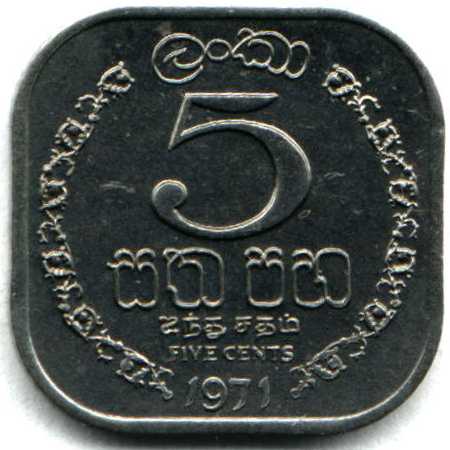
| ||||||||||||
| KM Unlisted | ||||||||||||||
|
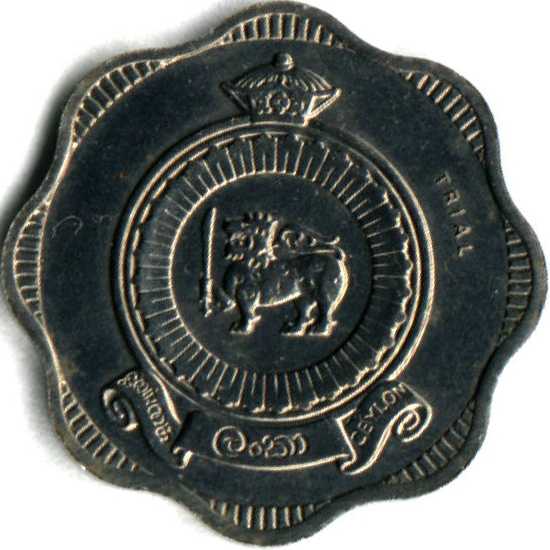
|
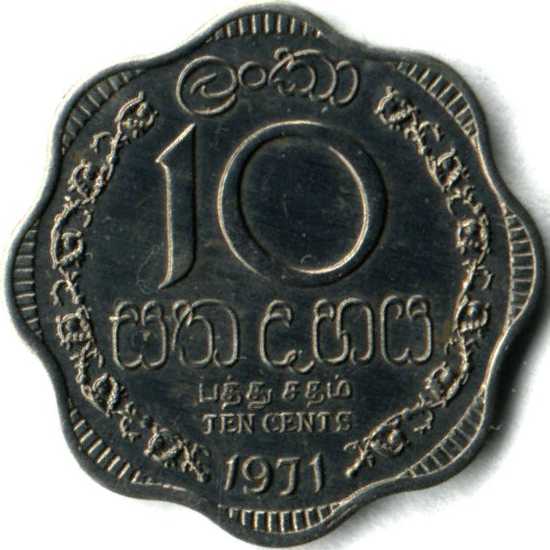
| ||||||||||||
| KM Unlisted | ||||||||||||||
Qualitative x-ray floresence spectra show the clear presence of Chromium with the Iron in the Chromized Steel TRIAL. Chromized Steel is Very difficult to fabricate high relief coins. 3-sets known in private hands.
A set of TRIAL patterns were struck in 1971 in Aluminum to select a cheaper alloy for the Five cents and Ten cents coins.
|
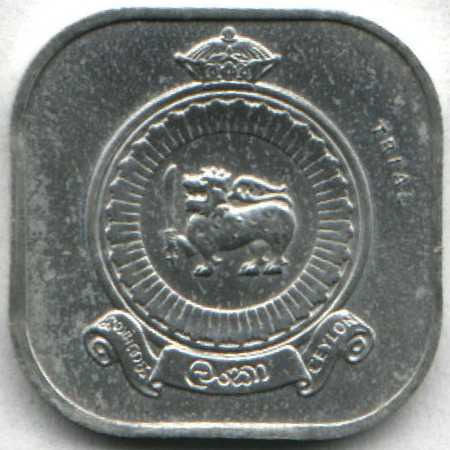
|
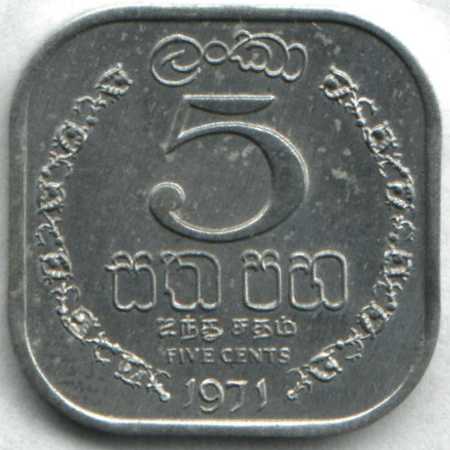
| ||||||||||||
| KM unlisted | ||||||||||||||
|
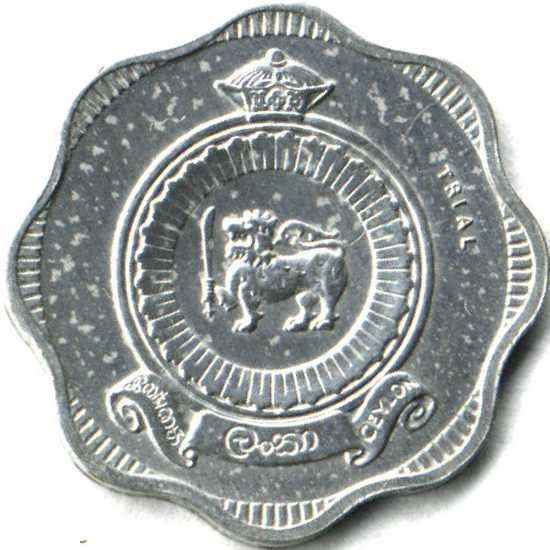
|
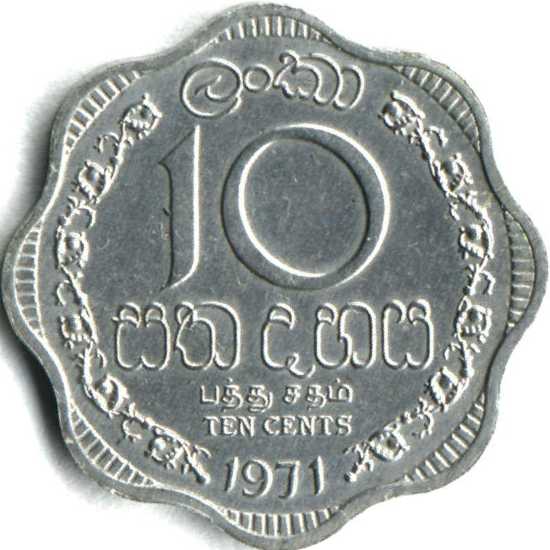
| ||||||||||||
| KM unlisted | ||||||||||||||
Obverse : The Armorial Ensign of Ceylon, with word TRIAL to the right
and upper side (2 O'clock) along the periphery.
Reverse : The large numeral with the value in Sinhala, Tamil and
English below and year of issue at the bottom within a circle of the
traditional Sinhala Liyavela art with Lanka in Sinhala on top.
3-sets known in private hands. Aluminum was adopted and made legal tender for the Five cents and Ten cents coins only from the 1978 issue.
|
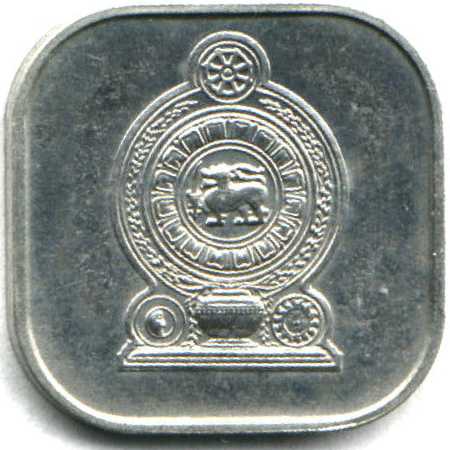
|
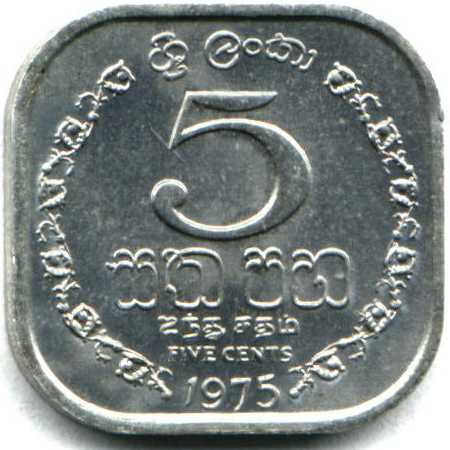
| ||||||||||||
| KM pn1 | ||||||||||||||
|
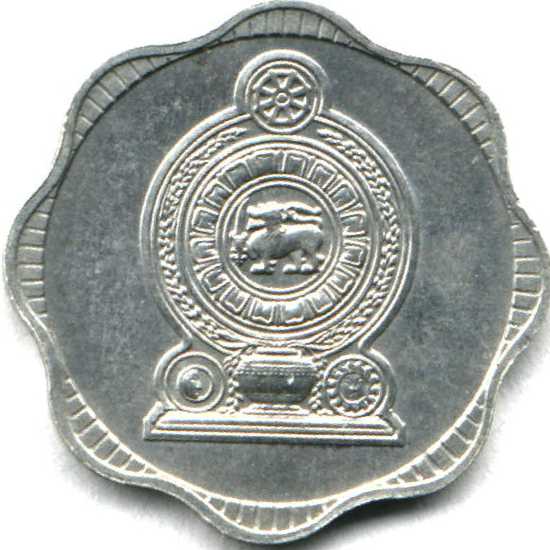
|
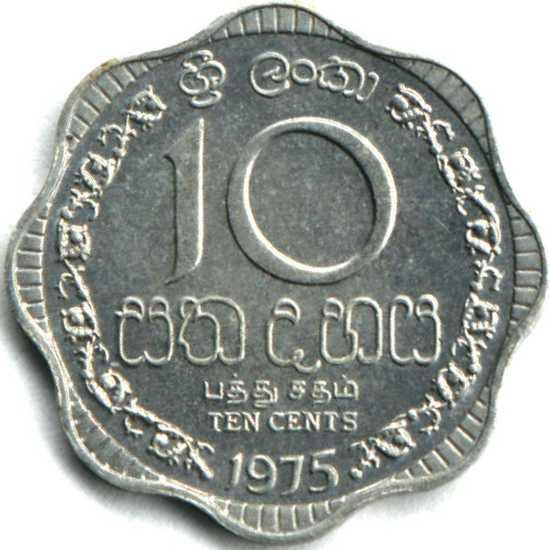
| ||||||||||||
| KM pn2 | ||||||||||||||
Obverse : The Armorial Ensign of Sri Lanka
Reverse : The large numeral with the value
in Sinhala, Tamil and English below and year of
issue at the bottom within a circle of the traditional Sinhala
Liyavela art with Lanka in Sinhala on top.
Retired officer T. M. U. Sallay of the
Central Bank of Ceylon, confirmed them to be official OMS patterns.
I was told that about 10 sets of this OMS exists.
They were listed for the first time in the 2003 SCWC (30th Edition)
These patterns were saved from possible destruction at a terrorist bombing in 1996 January by having been released/gifted by CBC many years previously. The stories behind these Lankan Patterns are probably as colorful and controversial in Sri Lanka as those of the US 1974 Aluminum Penny (OMS) that was proposed after extensive evaluation of a number of alternative metals including Bronze Clad Steel, Chromized Steel and Aluminum Alloys.
However, I also won a 1971 Chromarized Steel TRIAL of
10 cents on ebay from a collector in Belgium, who said
I purchased the trial coin 15 or maybe 20 years ago from a
person who worked at a Belgian factory of non-ferro metals.
The factory often melted coins for recycling the metals and got the
coins from a Mint house to re-melt, I suppose . This coin was a part
of a group of normal and common minor coins in different metals. So
the worker saved the coin from melting and I was lucky that I saw the
word TRIAL and the used metal.
When I inquired about the Royal Mint recycling on southasia-coins group
I was told that
Royal Mint practices did vary and scrap did go out of the mint -
their main problem was that they used quite a few different alloys
(for coins of 50+ medals etc) and when making blanks they needed
predictable raw materials to start with. The containers of odd bits,
floor sweepings miss-struck coins etc. were not of a predictable
metal content and so could not be easily recycled internally and so
were sold to outside contractors.
There is no record of the Birmingham Mint TRIAL in the Central Bank of Ceylon. Since, they were made to check on a subcontract to the Birmingham Mint, they would not have been sent to Ceylon. They must have escaped to the numismatic market via the same old lapse in security of the metal recycling.
Very much like the Five & Ten centsTRIAL coins struck in Lanka in 1971 in Nickel-Brass clad steel, Chromized steel, and Aluminum, and the 1975 Aluminum Off-Metal-Strikes (OMS) of these denominations, the US Mint in 1973 experimented again with alternative materials for Coinage. An Aluminum penny was recomended, in view of the increasing cost of Copper, but was rejected and after 1982 the penny has been minted as a copper plated zinc coin of 2.5 grams.
| The 1974 US Aluminum pattern weighs about 30% of a 3.11 gram copper-zinc Lincoln Memorial Cent that had been minted since 1959. See Mint may switch to Aluminum Cents (The Numismatist 1974 February, p. 270-271). |
The 1974 Aluminum cent although it was a business strike which the US-mint hoped to put into circulation. Since they got destroyed after it did not get congressional approval for released is in fact a Pattern. Interestingly it is however not listed in Krause, probably since none can be legally owned.
The reasons given in this report for recommending Aluminum and rejecting the alternative materials were
Several of the examples of the 1974 Aluminum patterns are said to have disappeared and few were recovered by Secret Service for the Mint and destroyed. One was deposited in the Smithsonian National Numismatic Collection by a staff director of a subcommittee. The article Gift, Theft or Find: The 1974 Aluminum Cent by David Ganz (Numismatist 2001 April p. 390-392,425-427) extract from 1990 letter the current attitude of the Mint on the 11 of the cents which were still outstanding. The Mint cannot pay a reward for their return: we regard them as our property, illegally issued into circulation.
For details see articles in The Numismatist and the Catalog
United States Patterns and Related Issues by Andrew W. Pollock
III 1994 Bowers and Merena Galleries, Inc. P 392-393.
I thank Andrew Pollock for a copy of the Treasury reports which make
very interesting reading on the U.S. mint selection process.